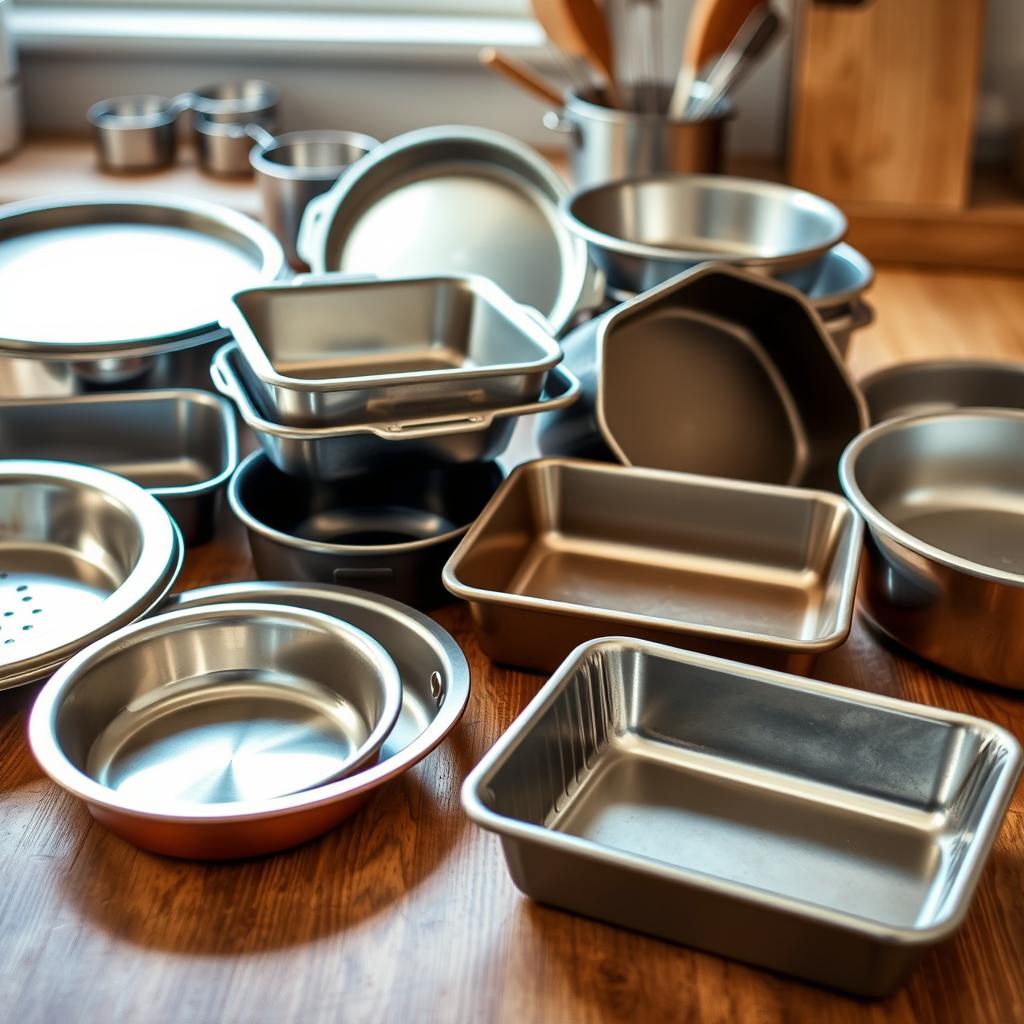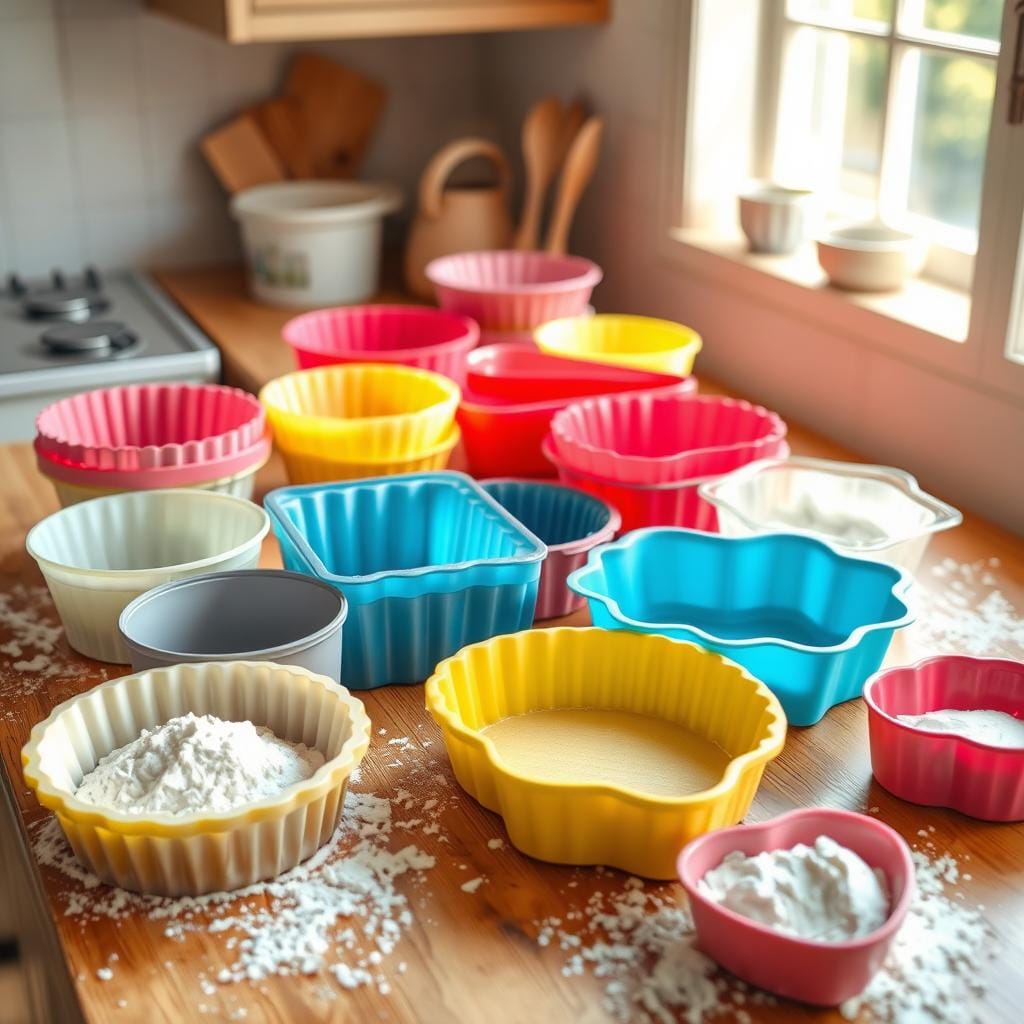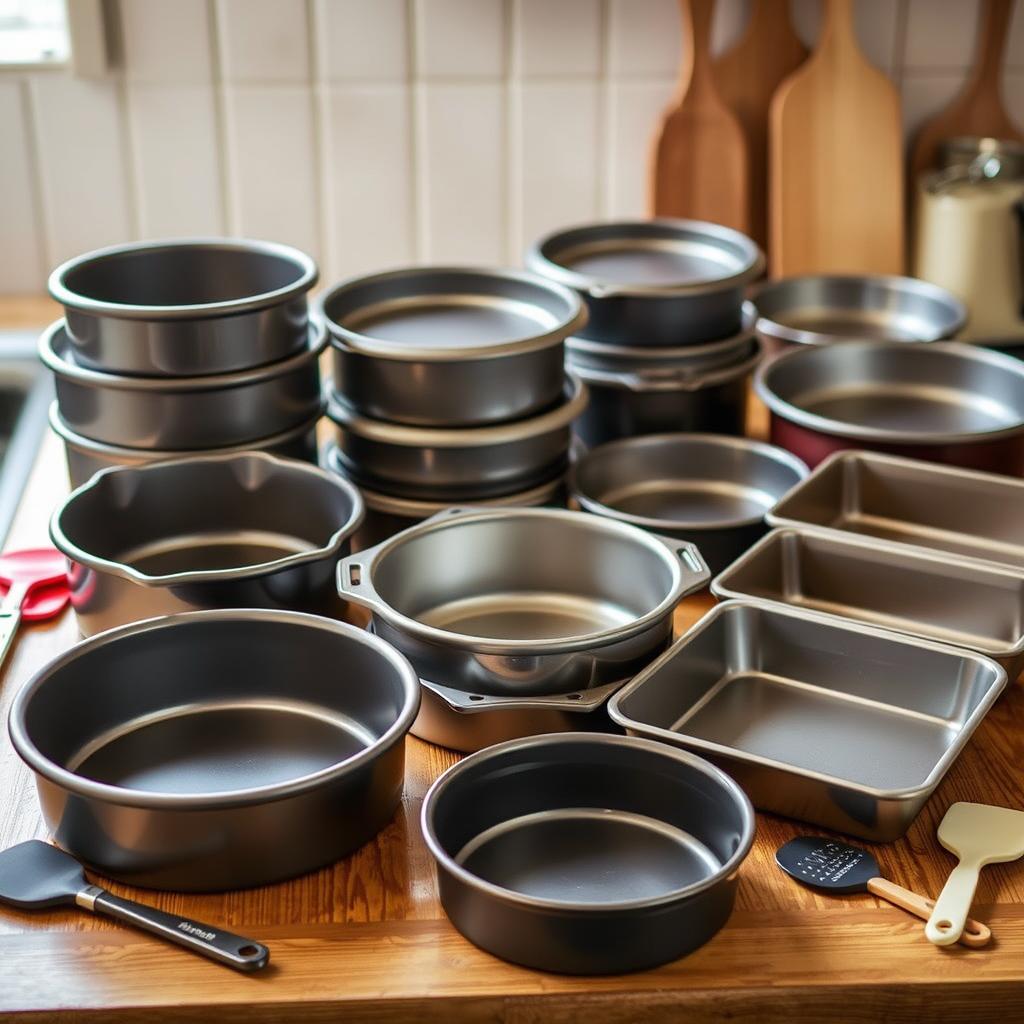As a former bakery owner, I’ve seen how a good cake pan can change everything. It’s not just a tool; it’s where your creations come to life. Whether you’re making a rich chocolate cake or a fluffy sponge, the right pan matters a lot. Let’s explore how to pick the best cake pan and take your baking to the next level.
Key Takeaways
- Understand the impact of cake pan material, size, and shape on baking results
- Discover the benefits of different bakeware options, from aluminum to silicone
- Learn how to select the right cake pan for specific recipes and desired outcomes
- Unlock professional tips for maintaining and extending the life of your cake pans
- Explore budget-friendly and premium cake pan options to find the best fit for your needs
Baking is a delicate art, and the right tools can make all the difference. By choosing the perfect cake pan, you’ll unlock a world of baking possibilities, ensuring your cakes turn out perfectly every time. Let’s dive in and discover the secrets to baking success!
Understanding Different Types of Cake Pan Materials
The type of cake pan you use can greatly affect your baking. From metal pans to silicone, each has its own benefits. Let’s look at the different materials and what they offer.
Aluminum vs. Stainless Steel Pans
Aluminum pans are great because they heat evenly. They’re also light, durable, and affordable. But, stainless steel pans are better for acidic batters because they don’t react with them. They also last a long time.
Glass and Ceramic Options
Glass and ceramic pans let you see how your cake is doing. They’re easy to clean and look beautiful. They’re perfect for those who like to watch their cakes bake.
Silicone Bakeware Benefits
Silicone pans are popular for their flexibility and non-stick surface. They’re easy to clean and come in many shapes. They’re great for trying out new cake designs.
| Material | Heat Conductivity | Durability | Non-Stick | Flexibility |
|---|---|---|---|---|
| Aluminum | Excellent | Durable | Varies | Rigid |
| Stainless Steel | Good | Highly Durable | Varies | Rigid |
| Glass | Good | Durable | Varies | Rigid |
| Ceramic | Good | Durable | Varies | Rigid |
| Silicone | Good | Durable | Excellent | Flexible |
Think about what you like to bake and how you want your cakes to look. With so many options, you can find the perfect pan for you.

Essential Cake Pan Sizes and Shapes
Having the right cake pan sizes and shapes is key when baking cakes. These tools can greatly affect your baking results. Whether you’re an experienced baker or new to cake making, knowing the essential pans is important.
The most common and essential cake pan sizes include:
- 8-inch round cake pans
- 9-inch round cake pans
- 13×9-inch rectangular baking pans
- 6-inch round cake pans
- Cupcake/muffin tins
These sizes are great for many cake recipes. You can make everything from classic layer cakes to sheet cakes and cupcakes. Specialty pans like Bundt and springform pans also offer unique shapes. They can add visual appeal and texture to your baked goods.
| Cake Pan Size | Typical Uses |
|---|---|
| 8-inch round | Layer cakes, cheesecakes |
| 9-inch round | Layer cakes, sheet cakes |
| 13×9-inch rectangular | Sheet cakes, baked desserts |
| 6-inch round | Smaller layer cakes, specialty cakes |
| Cupcake/muffin tins | Cupcakes, muffins |

By having a collection of these essential cake pan sizes and shapes, you’re ready for many baking accessories and recipes. You can make everything from classic cakes to creative desserts.
Features of High-Quality Cake Pan Construction
Baking the perfect cake starts with the right cake pan. High-quality pans have special features that lead to great results. Let’s look at what makes premium pans stand out.
Heat Distribution Properties
Even heat is key for a well-baked cake. Top nonstick pans spread heat evenly, helping your cake bake perfectly. Choose pans made of heavy-duty aluminum or stainless steel for the best heat transfer.
Durability Factors
Baking can be tough, and your pans need to handle it. Premium pans are built to last, resisting warping and damage. Durable pans mean less hassle and more baking joy.
Non-stick Coatings
A good non-stick coating makes cake release and cleanup a breeze. The best pans have silicone or ceramic coatings that prevent sticking. Just remember to care for the non-stick surface as directed.
Focus on these key features to improve your baking. With the right pans, you’ll make cakes that impress everyone. Get ready to become a baking star.
How to Select the Right Cake Pan for Specific Recipes
Choosing the right cake pan is key to baking a perfect cake. The size, shape, and material of the pan are crucial. They help your cake turn out just right, whether it’s a simple vanilla sponge or a complex layered cake.
Here are important factors to consider when picking a cake pan:
- Pan Size: Make sure the pan size matches the recipe. A pan that’s too small can overflow, while a too-large pan can make the cake dry. Always check the recipe for the right pan size.
- Pan Shape: Different recipes need different pan shapes. Round, square, rectangular, or specialty pans like Bundt or tube pans are all options. The shape affects the cake’s look and texture, so pick the right one.
- Pan Material: Cake pans are made from materials like aluminum, stainless steel, glass, ceramic, and silicone. Each material affects how the cake bakes. Think about what your recipe needs and what you like best.
Choosing the right cake pan can make your cakes amazing. Look for bakeware sets to build your collection. This will open up new possibilities in your baking.
| Pan Material | Heat Conduction | Advantages | Disadvantages |
|---|---|---|---|
| Aluminum | Excellent | Heats quickly, even heat distribution | Can react with acidic ingredients, may discolor over time |
| Stainless Steel | Good | Durable, easy to clean, non-reactive | Slower heat conduction, may result in uneven baking |
| Glass | Moderate | Transparent for easy monitoring, oven-safe | Slower heat conduction, may crack or shatter with rapid temperature changes |
| Silicone | Poor | Flexible, easy release, nonstick | May not brown cakes as well as metal pans |
Professional Tips for Cake Pan Maintenance
As a passionate home baker, keeping your cake tins in top shape is key. It ensures your cakes always taste great and look professional. Here are some expert tips for cleaning and storing your cake pans to make them last longer.
Cleaning Methods
First, make sure to clean your cake tins well. Don’t use rough scrubbers or harsh cleaners, as they can harm the pans. Instead, use a mild dish soap and a soft cloth or sponge. For tough spots, soak the pans in warm, soapy water before cleaning.
After cleaning, dry the cake tins completely. This helps prevent rust or color changes.
Storage Solutions
- Keep cake tins in a cool, dry spot, away from sunlight and moisture.
- Use pan protectors or nest pans to avoid scratches and dents.
- When stacking, place parchment paper or a silicone mat between pans to prevent sticking.
Extending Pan Lifespan
- Don’t use metal utensils on non-stick cake tins to avoid scratching the surface.
- Check your cake pans often and replace them if the non-stick coating wears off or the pan warps.
- Invest in quality baking accessories for better performance and longevity.
| Cake Pan Material | Cleaning Tips | Storage Recommendations |
|---|---|---|
| Aluminum | Warm, soapy water, avoid abrasives | Nest pans, use pan protectors |
| Stainless Steel | Warm, soapy water, mild abrasive if needed | Nest pans, use pan protectors |
| Silicone | Warm, soapy water, avoid harsh cleaners | Store flat or nested, avoid sharp objects |
By following these tips, your cake tins and other baking accessories will last longer. This means more delicious baking for you in the future.
Common Cake Pan Problems and Solutions
Baking with cake pans can sometimes present unexpected challenges. But with the right troubleshooting techniques, you can overcome these hurdles and achieve consistently delicious results. Let’s explore some common cake pan problems and discover effective solutions to ensure your cakes turn out perfectly every time.
Uneven Baking
If your cakes are baking unevenly, with some areas turning out dry or overcooked while others remain underbaked, the problem may lie in the heating distribution of your cake pan. Try rotating the baking pan halfway through the baking time to ensure even heat exposure. Investing in a high-quality cake pan with superior heat conduction properties can also help mitigate this issue.
Sticking and Tearing
Cakes sticking to the baking pan can be frustrating, leading to unsightly tears and crumbles when trying to remove the cake. Ensure your cake pan is properly greased or lined with parchment paper before pouring in the batter. Additionally, allow the cake to cool completely before attempting to remove it from the pan.
Warping and Distortion
Over time, cake pans can become warped or distorted, affecting the shape and structure of your cakes. To prevent this, avoid placing hot pans in cold water, which can cause the metal to warp. Instead, let the baking pan cool on a wire rack before handling. Choosing durable, high-quality cake pans can also help extend their lifespan and maintain their intended shape.
| Common Cake Pan Problem | Possible Causes | Solutions |
|---|---|---|
| Uneven Baking | – Uneven heat distribution in the pan – Poor quality pan material | – Rotate the pan halfway through baking – Use a high-quality pan with good heat conduction |
| Sticking and Tearing | – Insufficient greasing or lining of the pan – Attempting to remove the cake before it’s fully cooled | – Grease the pan or line it with parchment paper – Allow the cake to cool completely before removing |
| Warping and Distortion | – Sudden temperature changes (e.g., placing a hot pan in cold water) – Prolonged use of low-quality pans | – Let the pan cool on a wire rack before handling – Invest in durable, high-quality cake pans |
By understanding and addressing these common cake pan issues, you can ensure your baking endeavors are a resounding success, producing beautifully baked cakes every time.
Comparing Budget-Friendly vs Premium Cake Pan Options
Choosing the right cake pan is all about finding a balance between cost and quality. Budget-friendly options might seem attractive, but knowing the differences between them and premium pans is key. This knowledge helps you make a choice that fits your baking needs.
Price Range Analysis
Budget-friendly pans usually cost between $10 and $30. They’re made of thin aluminum, which might not distribute heat as well as premium pans. Premium pans, on the other hand, can cost $30 to $60 or more. They’re made of heavier materials and have better heat conduction and non-stick coatings.
Value for Money Considerations
- Budget pans might warp, stick, and bake unevenly, causing frustration and wasted ingredients.
- Premium pans are more durable, lasting longer and offering better value over time.
- They also distribute heat better and have non-stick coatings, leading to better baking results.
Choosing between budget and premium pans depends on your baking needs, budget, and goals. Budget pans are good for beginners, but serious bakers might find premium pans worth the investment. They offer better quality and results.
| Feature | Budget-Friendly Pans | Premium Pans |
|---|---|---|
| Price Range | $10 – $30 per pan | $30 – $60+ per pan |
| Material | Thin, lightweight aluminum | Heavyweight, high-quality materials (e.g., aluminized steel, cast aluminum) |
| Heat Distribution | Uneven, may lead to hot spots | Consistent, promoting even baking |
| Durability | Prone to warping and damage | Highly durable, long-lasting |
| Non-stick Coating | Basic, may wear off quickly | Advanced, long-lasting non-stick surface |
Must-Have Cake Pan Sizes for Home Bakers
As a home baker, having a good set of cake pans is key. It lets you make a variety of cakes with ease. Choosing a few key sizes can cover most of your baking needs.
The 9-inch round pan is a favorite for many. It works well for layer cakes, sponge cakes, and more. The 8-inch square pan is great for sheet cakes, brownies, and bars.
For layer cakes, having 6-inch and 8-inch round pans is a big help. They make it easy to create beautiful, even layer cakes. A 9×13-inch rectangular pan is also handy for sheet cakes, casseroles, and other treats.
| Cake Pan Size | Ideal for |
|---|---|
| 9-inch round | Layer cakes, sponge cakes |
| 8-inch square | Sheet cakes, brownies, bars |
| 6-inch and 8-inch round | Layered cakes |
| 9×13-inch rectangular | Sheet cakes, casseroles |
Getting these essential cake pan sizes will help you build a versatile baking accessories collection. It will be ready for many recipes and special occasions.
Special-Purpose Cake Pan Varieties
Exploring special cake pans can open up new creative possibilities. From Bundt pans to whimsical shapes, these pans can make your baking stand out. They help you create stunning cakes that impress your guests.
Bundt and Novelty Shapes
Bundt pans are a classic, known for their ring-shaped design. They come in many sizes and patterns, from traditional to elaborate shapes like castles and dinosaurs. Novelty molds let you bake cakes in fun shapes like animals and characters, adding a personal touch.
Layer Cake Essentials
For multi-tiered cakes, you need the right springform pans. These pans have removable sides, making layer cakes easy to assemble and decorate. Using different sizes of springform pans can create stunning, tiered cakes. Cake molds in various shapes and sizes help achieve a professional finish.
Specialty cake pans can take your baking to a new level. Whether you’re making a Bundt cake or a towering layer cake, these pans offer endless possibilities. They help you impress your loved ones with your baking skills.
How to Build Your Essential Cake Pan Collection
Creating the perfect cake begins with the right bakeware sets and cake pans. Building a solid cake pan collection is easy. Start with the basics and add more as you go. This way, you’ll have a variety of pans for all your baking needs.
First, get the basic cake pan sizes and shapes. An 8-inch and 9-inch round cake pan is a good start. They’re perfect for classic layer cakes. Also, consider an 8-inch or 9-inch square cake pan for sheet cakes and bars.
- 8-inch round cake pan
- 9-inch round cake pan
- 8-inch or 9-inch square cake pan
Next, look for bakeware sets with different sizes and shapes. Loaf pans, Bundt pans, and tube pans are great for trying new recipes. They let you explore different cake styles and flavors.
“Having a comprehensive cake pan collection allows you to tackle any baking project with confidence.”
It’s important to have a mix of essential and versatile pans. Quality bakeware sets and cake pans will help you make delicious cakes for years. Invest in durable pans for the best results.
Conclusion
When looking at all the cake pans out there, think about what you need and like. Aluminum pans offer even heat, stainless steel is tough, and silicone makes food easy to remove. The right pan can really help your baking.
Knowing what each pan material, size, and shape does helps you pick the best ones. You can go for classic round pans or try Bundt and fun shapes. Having a good set of pans opens up endless possibilities in the kitchen.
It’s also important to take care of your pans to make them last longer. Clean them right, store them well, and watch out for any issues. This way, your pans will stay in great shape for many bakes.

